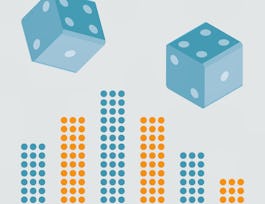This course is the third course in a 3-part specialization entitled "Statistics and Applied Data Analysis." The course is meant for those familiar with statistics but unfamiliar with the programming language R.



Statistics and Data Analysis with R
This course is part of Statistics and Applied Data Analysis Specialization

Instructor: Charlie Nuttelman
Sponsored by FutureX
Recommended experience
What you'll learn
Use statistical functions in RStudio to solve problems related to discrete and continuous probability distributions.
Create simple linear, polynomial, and multilinear regression models in RStudio and use those models to make predictions.
Perform one-sample and two-sample hypothesis tests and create confidence and prediction intervals on various statistics.
Skills you'll gain
- Probability & Statistics
- Regression Analysis
- Statistics
- Data Science
- Descriptive Statistics
- Statistical Hypothesis Testing
- Mathematics and Mathematical Modeling
- Statistical Programming
- Data Analysis
- Analytics
- Statistical Methods
- Statistical Modeling
- Statistical Inference
- Exploratory Data Analysis
- Statistical Analysis
- Probability Distribution
- R Programming
- Applied Mathematics
- Probability
- Mathematical Modeling
Details to know

Add to your LinkedIn profile
6 assignments
December 2024
See how employees at top companies are mastering in-demand skills

Build your subject-matter expertise
- Learn new concepts from industry experts
- Gain a foundational understanding of a subject or tool
- Develop job-relevant skills with hands-on projects
- Earn a shareable career certificate


Earn a career certificate
Add this credential to your LinkedIn profile, resume, or CV
Share it on social media and in your performance review

There are 6 modules in this course
Welcome to "Statistics and Data Analysis with R"! In this week, you will be introduced to R and RStudio and will learn how to install and navigate RStudio. You will then learn how to perform basic calculations, use script files, create and work with vectors and matrices, and install and load add-on packages. Finally, you will learn all about data frames and tibbles, how to import data from external files (.xlsx, .csv, and .txt files), and how to work with built-in and user-defined functions. When you are ready, you must pass the Week 1 Graded Quiz in order to access the Week 2 Starter Files and Cheat Sheet. You will need access to these items in order to complete Module 2. You must also pass Assignment 1, which counts towards the final grade in the course.
What's included
14 videos5 readings1 assignment1 programming assignment2 discussion prompts
In Week 2, you'll learn how to calculate common descriptive statistics in R, how to calculate conditional statistics, and how to present data in a graphical manner (scatter plots, column plots, and pie plots). You'll also learn how to create boxplots and probability plots in R and how to analyze the normality of the data using the Anderson-Darling statistic. Week 2 has 9 screencasts with many in-video questions to test your understanding of the material and help you learn. The week ends with a hands-on Assignment 2, which you will complete in a Jupyter notebook in the programming language R and that counts towards your final grade in the course. When you are ready, you must pass the Week 2 Graded Quiz in order to access the Week 3 Starter Files and Cheat Sheet. You will need access to these items in order to complete Module 3. Best of luck to you this week! As always, if you have questions or issues, please initiate a discussion thread and either myself or someone else will chime in with some help.
What's included
9 videos1 reading1 assignment1 programming assignment1 discussion prompt
In Week 3, you'll learn all about probability and counting rules in R, including how to calculate combinations and permutations, how to calculate probabilities associated with common discrete probability distributions (binomial, geometric, negative binomial, hypergeometric, Poisson distributions), and how to calculate probabilities associated with common continuous probability distributions (uniform, normal, T, chi-squared, and F distributions) in R. You will also perform inverse normal distribution calculations and their associated z-values (standardization). Week 3 has 14 screencasts with many in-video questions to test your understanding of the material and help you learn. The week ends with Assignment 3 in which you will perform several calculations in a Jupyter notebook. Assignment 3 counts towards your final grade in the course. When you are ready, you must pass the Week 3 Graded Quiz in order to access the Week 4 Starter Files and Cheat Sheet. You will need access to these items in order to complete Module 4. Best of luck to you this week! As always, if you have questions or issues, please initiate a discussion thread and either myself or someone else will chime in with some help.
What's included
16 videos1 reading1 assignment1 programming assignment1 discussion prompt
In Week 4, you'll learn all about how to calculate one-sample statistics in R. You will begin the week by learning how to calculate confidence and prediction intervals on the mean, variance, and binomial proportion. Then, you will learn how to perform hypothesis tests on the mean, variance, and a binomial proportion. You will also learn how to calculate the power and probability of a type II error in R, which is related to sample size considerations, which you will also explore. Week 4 has 10 screencasts with many in-video questions to test your understanding of the material and help you learn. I encourage you to download and make use of the Week 4 Cheat Sheet (for those who purchase a Course Certificate) as this will help distill the challenging concepts and R functions that are found in this week's material. Week 4 concludes with Assignment 4, which you will complete in the R programming language in a Jupyter notebook and that counts towards your final grade in the course. When you are ready, you must pass the Week 4 Graded Quiz in order to access the Week 5 Starter Files and Cheat Sheet. You will need access to these items in order to complete Module 5. Quiz 4 requires you to perform statistical calculations in R, so be sure to prepare accordingly.
What's included
12 videos1 reading1 assignment1 programming assignment1 discussion prompt
In Week 5, you'll learn all about two-sample comparisons. You will calculate confidence intervals related to and hypothesis tests involving the comparison of means, comparison of variances, and comparison of binomial proportions. The type of test that is performed depends on whether variance is known or unknown, which you will also explore. Week 5 has 7 screencasts with many in-video questions to test your understanding of the material and help you learn. The week concludes with Assignment 5. When you are ready, you must pass Quiz 5 in order to continue in the course. You will also want to pay close attention to the Week 5 Cheat Sheet (available to learners who purchase a Course Certificate) as this will serve as a great reference for Assignment 5 and Quiz 5. When you are ready, you must pass the Week 5 Graded Quiz in order to access the Week 6 Starter Files and Cheat Sheet. You will need access to these items in order to complete Module 6. Quiz 5 requires you to perform statistical calculations in R, so be sure to prepare accordingly.
What's included
7 videos1 reading1 assignment1 programming assignment1 discussion prompt
In Week 6, you'll learn all about creating simple linear, polynomial, and multilinear regression models, which basically are mathematical relationships between input variables (regressor variables) and an output variable (response). You will learn how to calculate confidence intervals on and perform hypothesis tests on model parameters and you will learn how to select the best possible regression model from several candidate models using backward elimination. Finally, you will learn how to perform analysis of variance (ANOVA) when you have more than two groups to compare. Week 6 has 9 screencasts with many in-video questions to test your understanding of the material and help you learn. The week concludes with Assignment 6. When you are ready, you must pass Quiz 6 in order to continue in the course. You will also want to pay close attention to the Week 6 Cheat Sheet (available to learners who purchase a Course Certificate) as this will serve as a great reference for Assignment 6 and Quiz 6. Quiz 6 requires you to perform statistical calculations in R, so be sure to prepare accordingly. Once you've completed Week 6, you'll be done with the course!
What's included
9 videos1 assignment1 programming assignment1 discussion prompt
Instructor

Offered by
Why people choose Coursera for their career




Recommended if you're interested in Data Science

Duke University

Coursera Project Network

Johns Hopkins University

University of Leeds

Open new doors with Coursera Plus
Unlimited access to 10,000+ world-class courses, hands-on projects, and job-ready certificate programs - all included in your subscription
Advance your career with an online degree
Earn a degree from world-class universities - 100% online
Join over 3,400 global companies that choose Coursera for Business
Upskill your employees to excel in the digital economy


